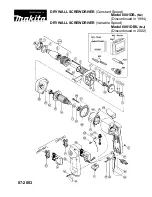
9
Overload protection
When the tool is operated in a manner that causes it to
draw an abnormally high current, the tool automatically
stops without any indications. In this situation, turn the
tool off and stop the application that caused the tool to
become overloaded. Then turn the tool on to restart.
Overheat protection for tool
When the tool is overheated, the tool stops automatically
and the battery indicator shows following state. In this
situation, let the tool cool before turning the tool on again.
015192
ASSEMBLY
CAUTION:
• Always be sure that the tool is switched off and the
battery cartridge is removed before carrying out any
work on the tool.
Installing or removing driver bit or socket bit
(Fig. 9)
Use only bits that has inserting portion shown in the
figure.
For tool with shallow bit hole
006348
For tool with deep bit hole
011405
Procedure 1 (Fig. 10)
For tool with normal sleeve
To install the bit, pull the sleeve in the direction of the
arrow and insert the bit into the sleeve as far as it will go.
Then release the sleeve to secure the bit.
For tool with one-touch type sleeve
To install the bit, insert the bit into the sleeve as far as it
will go.
Procedure 2 (Fig. 11)
In addition to the procedure (1) above, insert the bit-
piece into the sleeve with its pointed end facing in.
To remove the bit, pull the sleeve in the direction of the
arrow and pull the bit out.
NOTE:
• If the bit is not inserted deep enough into the sleeve,
the sleeve will not return to its original position and the
bit will not be secured. In this case, try re-inserting the
bit according to the instructions above.
• When it is difficult to insert the bit, pull the sleeve and
insert it into the sleeve as far as it will go.
• After inserting the bit, make sure that it is firmly
secured. If it comes out, do not use it.
Hook (Fig. 12)
The hook is convenient for temporarily hanging the tool.
This can be installed on either side of the tool.
To install the hook, insert it into a groove in the tool
housing on either side and then secure it with a screw. To
remove, loosen the screw and then take it out.
OPERATION (Fig. 13 & 14)
CAUTION:
• Never obstruct the air vents on the side of the tool for
cooling down oil unit and motor during operation.
Failure to do so may cause the tool excessive heat and
damage.
The proper fastening torque may differ depending upon
the kind or size of the screw/bolt, the material of the
workpiece to be fastened, etc. The relation between
fastening torque and fastening time is shown in the
figures.
(Fig. 15 & 16)
Hold the tool firmly and place the point of the driver bit in
the screw head. Apply forward pressure to the tool to the
extent that the bit will not slip off the screw and turn the
tool on to start operation.
NOTE:
• Use the proper bit for the head of the screw/bolt that
you wish to use.
• Choose a proper impact force and carefully adjust
pressure on the switch trigger so that the screw is not
damaged.
• Hold the tool pointed straight at the screw.
• For tightening bolt, select the soft or T mode impact
force grade.
• If the impact force is too strong, you tighten the screw
for a time longer than shown in the figures, the screw or
the point of the driver bit may be overstressed,
stripped, damaged, etc. Before starting your job,
always perform a test operation to determine the
proper fastening time for your screw.
The fastening torque is affected by a wide variety of
factors including the following. After fastening, always
check the torque with a torque wrench.
1.
When the battery cartridge is discharged almost
completely, voltage will drop and the fastening
torque will be reduced.
2.
Driver bit or socket bit
Failure to use the correct size driver bit or socket bit
will cause a reduction in the fastening torque.
3.
Bolt
• Even though the torque coefficient and the class of
bolt are the same, the proper fastening torque will
differ according to the diameter of bolt.
• Even though the diameters of bolts are the same,
the proper fastening torque will differ according to
the torque coefficient, the class of bolt and the bolt
length.
4.
The manner of holding the tool or the material of
driving position to be fastened will affect the torque.
5.
Operating the tool at low speed will cause a
reduction in the fastening torque.
Battery
indicator
: On
: Off
: Blinking
Tool is overheated
A = 12 mm
B = 9 mm
Use only these type of bit. Follow the
procedure (1).
(Note) Bit-piece is not necessary.
A = 17 mm
B = 14 mm
To install these types of bits, follow the
procedure (1).
A = 12 mm
B = 9 mm
To install these types of bits, follow the
procedure (2).
(Note) Bit-piece is necessary for
installing the bit.










































